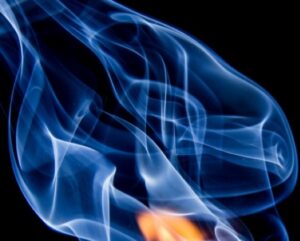You have probably heard of a flammable liquid, but have you heard of a combustible liquid? Actually, depending on who you are talking too, a flammable liquid can be a combustible liquid, but sometimes a combustible liquid cannot be a flammable liquid.
Confused yet? Not to worry.
We are going to walk through the difference between flammable vs. combustible liquids, the definition of combustible liquids, their flash points, and several common questions about combustible liquids.
You will be an expert by the end of this blog. Feel free to download this great chart that breaks down flammable and combustible liquids for you to reference as we go through.
TOPICS:
- What Are Flammable and Combustible Liquids?
- Flammable vs. Combustible Liquids
- Combustible Liquid Definition
- NFPA Flammable and Combustible Liquid Classifications
- OSHA Flammable and Combustible Liquid Categories
- What is a Flash Point?
- What is a Boiling Point?
- Does the Liquids Itself Burn or the Vapor?
- Why do the Definitions of “Flammable Liquid” and “Combustible Liquid” from NFPA Differ From Those Used By the U.S. Department of Transportation (DOT)?
- Are Combustible and Flammable Liquids Hazardous to Your Health?
- How Can I Safely Handle and Store Flammable and Combustible Liquids?
- Difference Between a Flammable and a Combustible Liquid
Let’s get started.
What Are Flammable and Combustible Liquids?
A few posts prior, we learned that the National Fire Protection Agency (NFPA) and the Occupational Safety and Health Administration (OSHA) have different definitions and classifications of flammable liquids.
As a reminder, let’s review.
Flammable vs. Combustible Liquids
NFPA splits flammable liquids into two types: flammable and combustible.
Whereas OSHA only has one type: flammable liquids.
Either way, these are liquids that can burn, or rather, the vapor they give off can burn.
Each organization mentioned above classifies the different types of liquids by their flash point and/or boiling point. (We will get into these in a moment.)
Generally, flammable liquids are more hazardous and harder to extinguish. Combustible liquids are harder to ignite because they usually need some kind of ignition source and are simpler to extinguish.
Due to this, flammable and combustible liquids are ranked from most hazardous to least hazardous in both organization’s systems. In other words, the lower a liquid’s flash point the more hazardous it is.
Combustible Liquid Definition
According to NFPA, a flammable liquid is a liquid with a closed-cup flash point less than 100°F (38°C), whereas a combustible liquid is a liquid with a closed-cup flash point greater than or equal to 100°F (38°C). The term “combustible liquid” is unique to NFPA classifications.
NFPA Flammable and Combustible Liquid Classifications
|
NFPA Flammable Liquid Types |
|
|
Type |
Flash Point Range |
|
Flammable Liquids |
< 100°F (38°C) |
|
Combustible Liquids |
≥ 100°F (38°C) |
According to NFPA, flammable liquids have a flash point below 100°F (38°C).
Class IA: Closed-cup flash point below 73°F (23°C) and a boiling point below 100°F (38°C). Examples: Diethyl Ether, Pentane, Ligroin, Heptane, Petroleum Ether.
Class IB: Closed-cup flash point below 73°F (23°C) and a boiling point at or above 100°F (38°C). Examples: Acetone, Benzene, Cyclohexane, Isopropyl Alcohol, Methyl Ethyl Ketone, Toluene, Ethanol.
Class IC: Closed-cup flash point at or above 73°F (23°C) and below 100°F (38°C). Examples: Xylene, Naphtha, Turpentine.
According to NFPA, combustible liquids have a flash point at or above 100°F (38°C).
Class II: Closed-cup flash point at or above 100°F (38°C) and below 140°F (60°C). Examples: Camphor Oil, Diesel Fuel, Pine Tar, Stoddard Solvent.
Class IIIA: Closed-cup flash point at or above 140°F (60°C) and below 200°F (93°C). Examples: Aniline, Benzaldehyde, Butyl Cellosolve, Nitrobenzene, Pine Oil, Formaldehyde.
Class IIIB: Closed-cup flash point at or above 200°F (93°C). Examples: Animal Oils, Ethylene Glycol, Glycerin, Lubricating, Quenching, and Transformer Oils, Triethanolamine, Benzyl Alcohol, Hydraulic Fluids, Vegetable Oils.
OSHA Flammable and Combustible Liquid Categories
|
OSHA Flammable Liquid Types |
|
|
Type |
Flash Point Range |
|
Flammable Liquids |
< 200°F (93°C) |
In contrast, since 2012 when some changes to the U.S. Labor Law were made, OSHA no longer refers to any liquids as “combustible”. They now refer to any liquid with a closed-cup flash point below 200°F (93°C) as a “flammable liquid”.
Category 1 Flammable Liquids: Closed-cup flash point below 73.4°F (23°C) and with a boiling point below 95°F (35°C). Examples: Diethyl ether, Pentane, Ligroin, Heptane, Petroleum ether
Category 2 Flammable Liquids: Closed-cup flash point below 73.4°F (23°C) and with a boiling point above 95°F (35°C). Examples: Acetone, Benzene, Cyclohexane, Isopropyl alcohol, Methyl ethyl ketone, Toluene, Ethanol
Category 3 Flammable Liquids*: Closed-cup flash point at or above 73.4°F (23°C) and below 140°F (60°C).
*When a Category 3 liquid with a flash point at or above 100°F (37.8°C) is heated for use to within 30°F (16.7°C) of its flash point, it shall be handled in accordance with the requirements for a Category 3 liquid with a flash point below 100°F (37.8°C).
Examples: Xylene, Naphtha, Turpentine, Camphor oil, Diesel fuel, Pine tar, Stoddard solvent.
Category 4 Flammable Liquids*: Closed-cup flash point at or above 140°F (60°C) and below 200°F (93°C).
*When a Category 4 flammable liquid is heated for use to within 30°F (16.7°C) of its flash point, it shall be handled in accordance with the requirements for a Category 3 liquid with a flash point at or above 100°F (37.8°C). When liquid with a flash point greater than 199.4°F (93°C) is heated for use to within 30°F (16.7°C) of its flash point, it shall be handled in accordance with the requirements for a Category 4 flammable liquid.
Examples: Aniline, Benzaldehyde, Butyl cellosolve, Nitrobenzene, Pine oil, Formaldehyde, Animal oils, Ethylene glycol, Glycerin, Lubricating, Quenching, Transformer oils, Triethanolamine, Benzyl alcohol, Hydraulic fluids, Vegetable oils.
What is a Flash Point?
Wondering what a flash point is at this point?
The flash point of a flammable or combustible liquid is the lowest temperature at which the liquids’ vapor can on fire.
These temperatures can vary so it’s best to use the lowest temperature to make sure you safely handle the substance.
There are different kinds of flash point tests, mainly open-cup and closed-cup; however, for this discussion all flash points mentioned are closed-cup flash points.
What is a Boiling Point?
Similarly, a boiling point is the lowest temperature at which a liquid will boil.
Did you notice in the classifications above that only NFPA’s Class IA and Class IB and OSHA’s Category 1 and Category 2 included boiling points?
That is because Class IA/Category 1 liquids are extremely volatile, but there are not very many liquids classified as such.
Theoretically, there is also no upper limit to Class IIIB, while OSHA caps Category 4 flammable liquids at 200°F (93°C).
Does the Liquids Itself Burn or the Vapor?
This is probably the most common question we get about combustible and flammable liquids.
It is the vapor that builds up on the surface of the liquid that burns, not the liquid itself.
These vapors can be present even at room temperatures.
Depending on the volatility of the liquid, when these vapors mix with air and other substances (like water) it can trigger a reaction.
Most often, these vapors are heavier than air so they will find the lowest point on the room to rest and can travel away from the source.
This is why good ventilation is so important in any area with flammable and combustible liquids to ensure there is no vapor buildup.

Why do the Definitions of “Flammable Liquid” and “Combustible Liquid” from NFPA Differ From Those Used By the U.S. Department of Transportation (DOT)?
Several years ago, the National Fire Protection Agency, Department of Transportation, and the Occupational Health and Safety Administration all got together and determined the definitions of flammable and combustible liquids.
Unfortunately, since then DOT and OSHA have amended their definitions to the non-uniform definitions we see today.
DOT changed its definition of “flammable liquid” and raised the cap to 141°F (60.5°C) because the United States is a part of the United Nations and must use the UN worldwide set of hazardous materials regulations definitions for international transportation.
There are certain domestic exemptions though.
In 2012, due to changes in the U.S. Labor Law, OSHA did away with the term “combustible liquid” altogether.
These classifications can change at any time so make sure you stay up to date on any new regulations in the industry.
Are Combustible and Flammable Liquids Hazardous to Your Health?
The most obvious health hazards of flammable and combustible liquids would be from flames or explosion.
Depending on the liquid, there can be other dangers to your health if it was breathed it in, absorbed into your skin, came into contact with your eyes, or was ingested.
This is precisely why every flammable and combustible liquid has what is called a Safety Data Sheet (SDS) that describes all of its properties, classification, health hazards, and how to treat them.
Keep in mind that not only can liquids be flammable and combustible, but corrosive as well.
Sometimes even both!
In the next blog, we will breakdown how flammable liquids and corrosive liquids are related.
How Can I Safely Handle and Store Flammable and Combustible Liquids?
If you only have a small amount of flammable liquids on site, then you are required for safety reasons to only have certain amounts of each class of liquid.
They also must be stored in an approved flammable liquid cabinet built to particular specifications. OSHA has very specific rules for storing flammable liquids.
On the other hand, if you require larger amounts of flammable liquids that exceed the storage cabinet limit or on-site storage room limits (which are expensive to build out as well), then there is another option.
Flammable liquid warehousing facilities can be an affordable avenue for those that do not want to store their flammable and combustible liquids on-site.
These warehouses are specialized specifically for flammable liquids and are certified and approved to handle hazardous materials.
Oftentimes, they also offer additional chemical third-party logistics services as a value add to their customers.
This is a great way to safely and effectively manage your flammable liquid storage, handling, and transportation.
So, What is the Difference Between a Flammable and a Combustible Liquid?
Let’s review.
NFPA, DOT, and OSHA have varying definitions for flammable and combustible liquids.
Combustible liquids are unique to NFPA’s definition, where a flammable liquid has a closed-cup flash point less than 100°F (38°C), and a combustible liquid has a closed-cup flash point greater than or equal to 100°F (38°C).
There are six NFPA classes of flammable/combustible liquids.
OSHA does not refer to combustible liquids, only flammable liquids, which have a flash point less than 200°F (93°C).
There are four OSHA categories of flammable liquids.
It is very important to remember that there are other regulatory organizations that define flammable and combustible liquids in different ways.
Before doing anything, make sure you consider the application of the material (and therefore which regulation applies) when dealing with flammable and combustible materials.
[DOWNLOAD] PDF: FLAMMABLE LIQUID CATEGORIES CHART
Disclaimer:
All content on this website is for informational purposes only. This information should not be considered complete, up to date, and is not intended to be used in place of the consultation or advice of a legal, medical, or any other professional. Chemical Strategies, Inc. assumes no responsibility or liability for any errors or omissions in the content of this site. We do not make any warranties about the completeness, reliability, and accuracy of this information. You use all information at your own risk.

